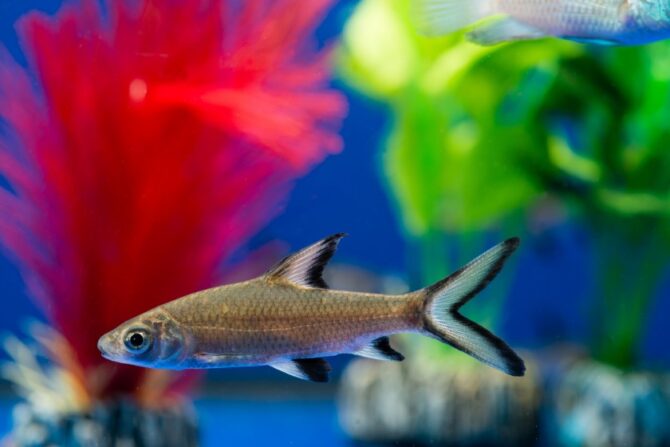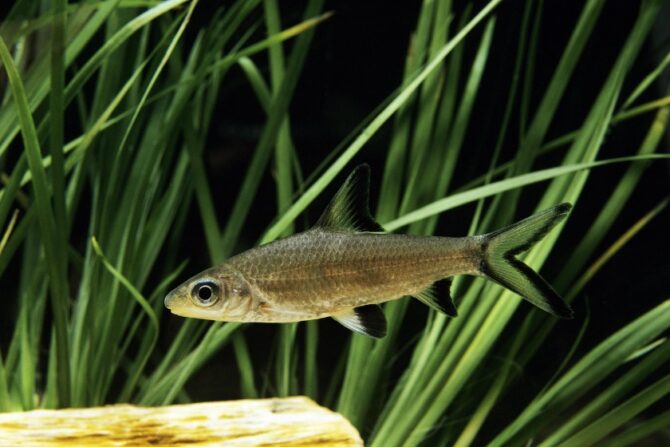Bala sharks are popular for their docile behavior despite their large size and intimidating appearance.
It’s no wonder they are also called gentle giants.
But their docility isn’t the only trait people know this animal for.
This fish is also popular for twitching in ways that seem unnatural.
Why do Bala sharks twitch? Are they doing it for fun, or is there more to it?
Twitching is an involuntary response commonly observed in some species when stressed, including humans and pufferfish. Due to the Bala shark’s large size and tonnage, it’s more likely that the twitches serve a protective purpose rather than a predatory one.
However, it’s unclear if the twitches are pain responses or if they have any other functions.
Read on to learn more about this fascinating shark species and their unusual twitching behavior.
Bala Shark Basics: What You Need To Know

Bala sharks are fishes from Southeast Asia. Although they are called sharks, these fishes are not true sharks.
They make interesting pets because of their distinct shark-like look and size.
These fishes can be found in tropical and subtropical oceans all around the world.
They are fascinating and recognized for their peculiar behavior and looks.
Bala sharks have large snouts and narrow rostral teeth, which they use to feed on insects and aquatic prey with soft bodies, like krill and small fish.
Although the appearance of Bala shark species varies, they all share distinctive characteristics, including a metallic silver body with yellow to black margins on their dorsal, caudal, pelvic, and anal fins.1
Bala sharks are also fast swimmers and can twitch for extended periods, which is called “continuous undulating movement.”
Understanding why these sharks twitch and the function of this movement will reveal even more about them.
Why Do Bala Sharks Twitch? Theories Offered

Unfortunately, the answer to this question is not straightforward.
While there are many theories about why Bala sharks twitch, several of them are incorrect.
The Bala shark’s twitches are a mysterious phenomenon that has baffled researchers for decades.
Its body suddenly jerks rapidly and erratically, causing it to move in unpredictable ways.
This is often believed to be due to stress or excitement.
While scientists have tried to understand this behavior, little is known about how it works or why it occurs.
Still, there are many theories about why the Bala shark twitches, and here are seven of them:
Theory 1
Twitching is a form of communication among Bala sharks to show other members of their species what they are feeling or thinking.
This is similar to humans using facial expressions and vocalizations to communicate with each other when they’re alone.
This theory is supported by the fact that when one Bala shark starts to twitch, others will also begin to do so.
Twitching seems universal among all Bala shark species, so it must be something crucial to their survival.
Theory 2
Twitching in Bala sharks may be an instinctual response to defend itself against predators such as humans.
Theory 3
The Bala shark’s twitches might be caused by electrical impulses in their brains and fluid movement in their bodies.
Theory 4
The Bala shark twitches to let other sharks know they’re ready for the mating season or to mate themselves!
Theory 5
Twitching in Bala sharks is most likely involuntary and serves as a means for the shark to attract attention in a high-stress situation.
Theory 6
These twitches are also speculated to help Bala sharks move faster and more efficiently in water.
No wonder they’re one of the lake’s finest and fastest swimmers!
Theory 7
They probably use this behavior to catch smaller fish, squid, or other aquatic animals for food.
How Does Twitching Affect the Bala Shark?

Bala sharks are fast swimmers due to their unusual twitching activity, which allows them to move through the water more effectively than other sharks and fishes.
So far, it seems their twitching isn’t linked to negative factors like stress, nervousness, or even an illness.
But while there’s no solid evidence that these factors always cause twitching, do not rule them out, especially if a Bala shark is constantly twitching.
In such a case, it helps to check for other signs that might indicate a health issue.
Do Twitches Help Bala Sharks Find Food?

Sharks are predators with a unique way of hunting prey, and they rely on speed to do so.
On TV shows and documentaries, you may have noticed that sharks move faster than most people would assume.
This is also true for the Bala shark, and its twitching comes in handy when it comes to speed.
Twitching helps Bala sharks evade any predator when they aren’t in captivity.
However, Bala sharks are sometimes preyed upon by other aquatic animals like piranhas, wolf fish, and wolf cichlids.
Additional Information: What Size Tank Do You Need For A Bala Shark?

Bala sharks are less aggressive than freshwater sharks and should not be kept with larger fish species known to be aggressive, like African cichlids or oscars.2
Although Bala sharks aren’t aggressive, you might want to think twice before adding them to a community tank with smaller fish.
While Bala sharks won’t readily go after fish species in your aquarium, they could see smaller fish as food.
When it comes time to choose what kind of aquarium size you’ll need for your new pet Bala shark, keep these things in mind:
- A mature adult female needs at least 55 gallons (210 liters) of water per year.
- Males require more space than females because they grow bigger than females do during maturity.
- The most typical recommended tank size for keeping a school of Bala sharks is between a 120- and 150-gallon tank, which is a rather sizable aquarium.
Frequently Asked Questions
Why Do Bala Sharks Twitch?
We can’t say precisely why Bala sharks twitch, but it’s fair to assume they have a good reason for doing this.
Since a Bala shark’s twitching can make it swim extremely fast, it is safe to conclude that these twitches are behavior that has stuck with them over time and are quite helpful in escaping predators or sneaking up on their prey.
There is also the school of thought that this twitching might be a way for Bala sharks to communicate with other sharks.
Do Bala Sharks Jump?
When scared or nervous, Bala sharks react by jumping.
They can leap as high as six feet.
That’s why it’s advised to make sure your tank has a tight-fitted lid in cases where you put the sharks in a tank.
Are a Bala Shark’s Twitches Normal?
Twitching is normal for Bala sharks because it aids in their movement in the water.
Their peculiar twitches also make the Bala shark one of the oceanic community’s most remarkable and distinctive members.
Could a Bala Shark’s Twitches Be a Sign of Stress?
Shaking and twitching are signs of stress that can be caused by several factors, but they’re most commonly caused by anxiety or excitement.
Bala sharks are known for their large size and curious nature, so it’s not surprising that you’ll see them twitch when they feel threatened.
Conclusion
Bala sharks are large fishes that require a lot of care and maintenance.
Their twitches are believed to help them find food, communicate and stay safe, but other factors like stress or illness can also cause them.
Although there are many hypotheses on this behavioral propensity, it is difficult to try to provide a conclusive answer to the question, “Why do Bala sharks twitch?”
Unless there are other signs that your Bala shark could be ill, there’s no need to be alarmed at the first sign of twitching.
References & Notes
- Bala Shark (Balantiocheilus melanopterus). Tropical Fish Keeping
- Bala Shark (Balantiocheilus Melanopterus): Ultimate Care Guide. Fish Laboratory Aquatics






